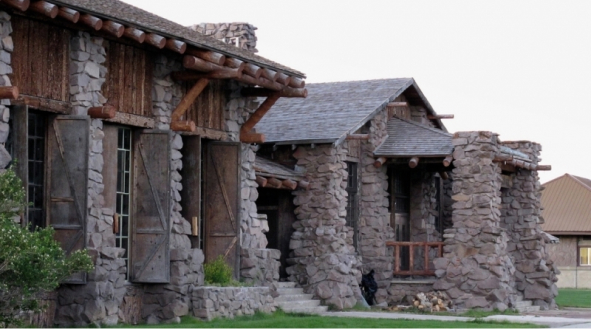Q. Why is there no fishing from Fishing Bridge?
A. Because the gravelly bottom of the Yellowstone River at the outlet of the lake is a major spawning area for the cutthroat trout. Overfishing from this once popular fishing spot contributed to the decline of the cutthroat trout in the lake, which is home to the largest inland population of cutthroat trout in the world. Fishing was prohibited from the bridge in 1973.
Q. Where is the NPS campground at Fishing Bridge?
A. The Park Service campground, a memorable camping spot for many, was removed in 1989 in compliance with the final decision on the Fishing Bridge EIS of 1988. That planning document called for this and other closures because of the notably high occurrence of bear/human conflicts and the ecological importance of this area to the grizzly bear, a threatened species.
Q. How big is Yellowstone Lake? How deep is it? Is it natural?
A. Yellowstone Lake has 136 square miles of surface area and 110 miles of shoreline. Its deepest spot is in excess of 390 ft. according to recent research. It is a natural lake.
Q. Is Yellowstone Lake the largest lake in the world?
A. No. It is the largest lake at high elevation in North America (above 7,000 ft.). Lake Tahoe is larger, though it is at lower elevation
Q. Where does the Yellowstone River begin? Where does it end?
A. It begins on the slopes of Yount Peak in the Absaroka Mountain Range outside the southeast boundary of the park and completes its 671-mile run by joining the Missouri River near the Montana and North Dakota border. Its waters then travel to the Mississippi River and on to the Atlantic Ocean at the Gulf of Mexico.
Q. What kind of fish live in Yellowstone Lake?
A. Yellowstone cutthroat trout, longnose dace, redside shiners, longnose suckers, and lake chubs. In the summer of 1994, illegally introduced lake trout were discovered in Yellowstone Lake. Cutthroat trout and longnose suckers are often seen from Fishing Bridge. The longnose dace, redside shiners, and lake chubs are all small minnows and are, therefore, harder to detect from the bridge.
Q. What fish are native to Yellowstone Lake?
A. Yellowstone cutthroat trout and possibly the longnose dace are native to Yellowstone Lake; the other fish were most likely introduced by anglers. While the Yellowstone cutthroat trout inhabit Yellowstone Lake, other types of cutthroat trout are found elsewhere in Yellowstone waters, including the west-slope cutthroat and the Snake River (or fine-spotted) cutthroat.
Q. Why do I have to throw the big ones back?
A. As a means of protecting the cutthroat trout population, which is threatened by the illegal introduction of lake trout, new catch-and-release regulations were instituted in 1998. Prior to July 15, any size cutthroat trout caught must be returned to the lake. After July 15, the limit on cutthroat trout caught in Yellowstone Lake is two fish under 13 inches in size per day. This is because the larger fish are more productive spawners.
Q. Where can I see a moose?
A. Moose are seen fairly commonly in the Lake District. Look in the marshy areas around the river, particularly at the Fishing Bridge. They are also seen with some frequency in the large meadows near Bridge Bay and the marshes along Pelican Creek. Moose are most often seen at dawn and dusk.
Q. At Mud Volcano: What's that smell?
A. Hydrogen sulfide gas gives the mud pots their infamous "rotten egg" smell. Sulfur, in the form of iron sulfide, gives the features their many shades of gray.




